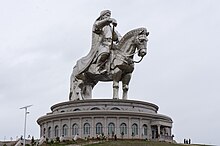The Genghis Khan Equestrian Statue, part of the Genghis Khan Statue Complex, is a 40-metre (130 ft) tall, stainless steel statue of Genghis Khan on horseback and the world's tallest equestrian statue.[2] It is located about a mile from the Tuul River at Tsonjin Boldog, 54 km (33.55 mi) east of the Mongolian capital Ulaanbaatar, where, according to legend, he found a golden whip. The statue is symbolically pointed east towards his birthplace. It is on top of the Genghis Khan Statue Complex, a visitor centre, itself 10 metres (33 ft) tall, with 36 columns representing the 36 khans from Genghis to Ligdan Khan. It was designed by sculptor D. Erdenebileg and architect J. Enkhjargal and erected and opened in 2008 to honor the 800th anniversary of the founding of the Mongol Empire.[3]
Чингис хааны морьт хөшөө | |
 | |
 | |
| 47°48′29.00″N 107°31′47.10″E / 47.8080556°N 107.5297500°E | |
| Location | Ulaanbaatar, Mongolia |
|---|---|
| Designer | D. Erdembileg (sculptor) J. Enkhjargal (architect) |
| Type | Equestrian statue |
| Material | Stainless steel[1] |
| Height | 40 metres (130 ft) |
| Completion date | 2008 |
| Dedicated to | Genghis Khan |
Visitors walk to the head of the horse through its chest and neck, where they have a panoramic view. The main statue area will be[when?] surrounded by 200 ger (yurts),[4] designed and arranged like the pattern of the horse brand marks that were used by the 13th century Mongol tribes. The cost of the complex is reported to be US$4.1 million, built by The Genco Tour Bureau, a Mongolian company.[1]
The attached museum has exhibitions relating to the Bronze Age and Xiongnu archaeological cultures in Mongolia, which show everyday utensils, belt buckles, knives, sacred animals, etc. and a second exhibition on the Great Khan period in the 13 and 14th centuries which has ancient tools, goldsmith subjects and some Nestorian crosses and rosaries. Adjacent to the museum is a tourist and recreation centre, which covers 212 hectares (520 acres).
Gallery
edit-
View of statue and gateway
-
Face of statue as viewed from observation deck
-
The main road leading to the statue
-
View of the theme park from the observation deck on the statue
-
The gates before the statue
-
Distance view of the statue
See also
editReferences
edit- ^ a b Levin, Dan (August 2, 2009). "Genghis Khan Rules Mongolia Again, in a P.R. Campaign". The New York Times. Retrieved 29 December 2016.
- ^ Daisy Sindelar (13 February 2010). "From Chinggis Khan to Prayer Wheels, Mongolians Reclaim What's Theirs". Radio Free Europe. Retrieved 10 November 2021.
- ^ "The Chinggis Khan Statue Complex". Mongolian National Tourism Organization. Archived from the original on 2012-04-25. Retrieved 2011-11-20.
- ^ Chinggis khan statue complex Archived 2012-07-05 at the Wayback Machine